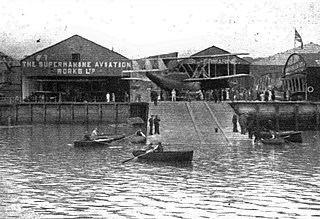Related Research Articles

Supermarine was a British aircraft manufacturer. It is most famous for producing the Spitfire fighter plane during World War II. It also built a range of seaplanes and flying boats, winning the Schneider Trophy for seaplanes with three wins in a row in 1927, 1929 and 1931. After the war, the company produced a series of jet fighters.

The Palatine Hill, which relative to the seven hills of Rome is the centremost, is one of the most ancient parts of the city; it has been called "the first nucleus of the Roman Empire". The site is now mainly a large open-air museum whilst the Palatine Museum houses many finds from the excavations here and from other ancient Italian sites.

The Domus Aurea was a vast landscaped complex built by the Emperor Nero largely on the Oppian Hill in the heart of ancient Rome after the great fire in 64 AD had destroyed a large part of the city.
The year 2000 in archaeology included many events, some of which are listed below.

The History of Rome, perhaps originally titled Annales, and frequently referred to as Ab Urbe Condita, is a monumental history of ancient Rome, written in Latin between 27 and 9 BC by the Roman historian Titus Livius, better known in English as "Livy". The work covers the period from the legends concerning the arrival of Aeneas and the refugees from the fall of Troy, to the city's founding in 753 BC, the expulsion of the Kings in 509 BC, and down to Livy's own time, during the reign of the emperor Augustus. The last event covered by Livy is the death of Drusus in 9 BC. 35 of 142 books, about a quarter of the work, are still extant. The surviving books deal with the events down to 293 BC, and from 219 to 166 BC.
The year 1972 in archaeology involved some significant events.
The year 1976 in archaeology involved some significant events.
This page lists major events of 2001 in archaeology.
The year 1961 in archaeology involved some significant events.
The year 1965 in archaeology involved some significant events.
The year 1979 in archaeology involved some significant events.
Below are notable events in archaeology that occurred in 1936.
The Antikythera wreck is a Roman-era shipwreck dating from the second quarter of the first century BC.

The Temple of Claudius or Temple of the Deified Claudius was a large octastyle temple built in Camulodunum, the modern Colchester in Essex. The main building was constructed between 49 and 60 AD, although additions were built throughout the Roman-era. Today, it forms the base of the Norman Colchester Castle. It is one of at least eight Roman-era pagan temples in Colchester, and was the largest temple of its kind in Roman Britain; its current remains potentially represent the earliest existing Roman stonework in the country.
The decade of the 1780s in archaeology involved some significant events.
Petuaria was originally a Roman fort situated where the town of Brough in the East Riding of Yorkshire now stands. Petuaria means something like 'quarter' or 'fourth part', incorporating the archaic Brythonic *petuar, 'four'.
This page lists major events of 2009 in archaeology.
The year 2012 in archaeology involved some significant events.
References
- ↑ Albertson, Fred C.(2001). "Zenodorus's "Colossus of Nero"". Memoirs of the American Academy in Rome
- ↑ Ranter, Harro. "Incident Supermarine Spitfire Mk Ia N3200, 26 May 1940". aviation-safety.net. Retrieved 2020-12-27.
- ↑ "The Spitfire lost for almost 50 Years". Imperial War Museums. Retrieved 2020-12-27.
- ↑ Gabriellin, Chantal (2003). "Lucius Postumius Megellus at Gabii: A New Fragment of Livy". The Classical Quarterly . New Series. 53 (1): 247–259. doi:10.1093/cq/53.1.247. hdl: 2158/431091 . JSTOR 3556494.
- ↑ "Protected Wrecks". historicengland.org.uk. Retrieved 5 June 2017.
- ↑ "Glyn Daniel". British Film Institute. Retrieved 30 May 2017.[ dead link ]